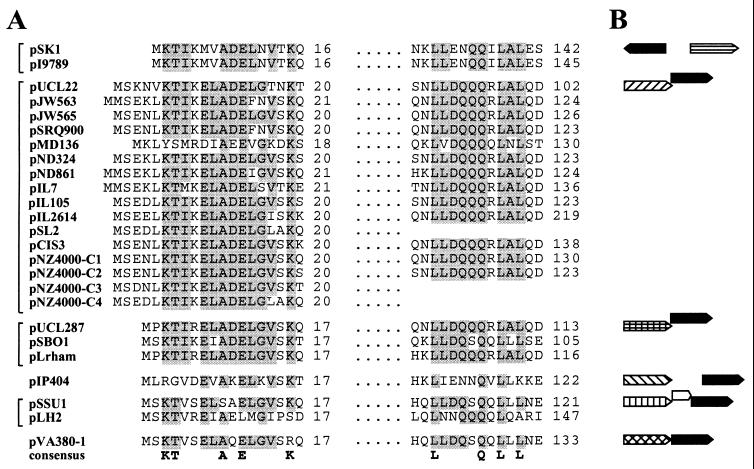FIG. 4.
(A) Multiple amino acid sequence alignment of segments conserved in Orf245 and related proteins. Residues present in at least 75% of the sequences at any one position are shaded, and amino acids present in at least 90% are indicated in a consensus line at the bottom. The dots denote sequences between the conserved regions that have been omitted for clarity. The amino acid sequences were obtained from the following GenBank entries: pUCL22, X60454; pJW563, X85168; pJW565, Y12736; pSRQ900, AF001314; pMD136, AF069302; pND324, U44843; pND861, AF034786; pIL7, Z25475; pIL105, AF116286; pIL2614, U90222; pSL2, X56550; pCIS3, AF153414; pNZ4000 (C1 to C4), AF036485; pUCL287, X75607; pSBO1, AB021464; pLrham (unnamed plasmid from Lactobacillus rhamnosus), AF037091; pIP404, M32882; pSSU1, AB019522; pLH2, X81981; and pVA380-1, L23803. For each segment, the amino acid number of the rightmost amino acid of a sequence is shown. Proteins from plasmids possessing related replication initiation genes are bracketed. The Orf245-like protein from pSL2, and two of the four homologs carried by pNZ4000, appear to be truncated and therefore do not possess the second conserved region. (B) For the top plasmid of each replicon class shown in panel A, the genetic organization of the gene encoding the Orf245-like protein, with respect to its associated rep gene, is represented diagrammatically. Distinct rep genes are represented by different patterned boxes, whereas orf245 homologs are denoted by solid boxes, and the genes' directions of transcription are indicated by arrowheads on the boxes; note that genes are not drawn to scale.

